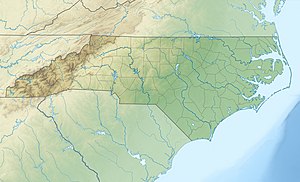Marys Creek (Haw River tributary)
| Marys Creek Tributary to Haw River | |
|---|---|
| Location | |
| Country | United States |
| State | North Carolina |
| County | Alamance |
| Physical characteristics | |
| Source | divide between Marys Creek and Varnals Creek |
| • location | about 5 miles southeast of Rock Creek, North Carolina on the west side of Bass Mountain |
| • coordinates | 35°56′27″N 079°24′06″W / 35.94083°N 79.40167°W[1] |
| • elevation | 735 ft (224 m)[2] |
| Mouth | Haw River |
• location | about 3 miles southeast of Saxapahaw, North Carolina |
• coordinates | 35°55′28″N 079°17′56″W / 35.92444°N 79.29889°W[1] |
• elevation | 407 ft (124 m)[1] |
| Length | 9.74 mi (15.68 km)[3] |
| Basin size | 12.51 square miles (32.4 km2)[4] |
| Discharge | |
| • location | Haw River |
| • average | 14.80 cu ft/s (0.419 m3/s) at mouth with Haw River[4] |
| Basin features | |
| Progression | Haw River → Cape Fear River → Atlantic Ocean |
| River system | Haw River |
| Tributaries | |
| • left | unnamed tributaries |
| • right | unnamed tributaries |
| Bridges | Thompson Mill Road, Snow Camp Road, Jewell Road, Lindley Mill Road, Stockland Road, NC 87, Whitney Road |
Marys Creek is a 9.74 mi (15.68 km) long 3rd order tributary to the Haw River, in Alamance County, North Carolina.
Course
Marys Creek rises on the west side of Bass Mountain, about 5 miles southeast of Rock Creek in Alamance County, North Carolina and then flows east to the Haw River about 3 miles southeast of Saxapahaw, North Carolina.[2]
Watershed
Marys Creek drains 12.51 square miles (32.4 km2) of area, receives about 46.6 in/year of precipitation, and has a wetness index of 425.73 and is about 44% forested.[4]
See also
References
- ^ a b c "GNIS Detail - Marys Creek". geonames.usgs.gov. Locality, LLC. Retrieved 2 October 2019.
- ^ a b "Cane Creek Mountains Topo Map, Alamance County NC (Snow Camp Area)". TopoZone. Locality, LLC. Retrieved 1 October 2019.
- ^ "ArcGIS Web Application". epa.maps.arcgis.com. US EPA. Retrieved 2 October 2019.
- ^ a b c "Marys Creek Watershed Report". Waters Geoviewer. US EPA. Retrieved 2 October 2019.
Additional Maps




